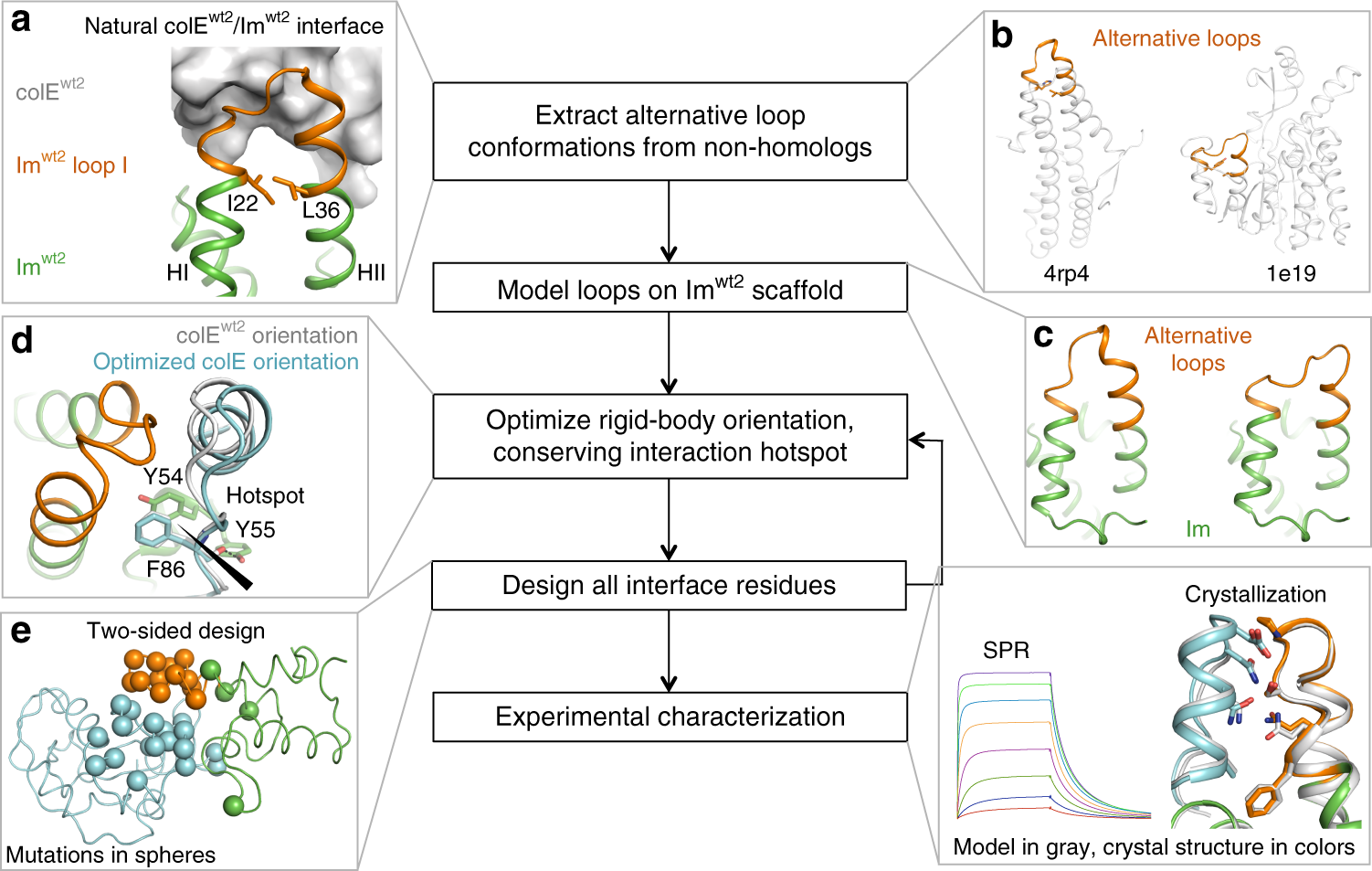www.nature.com/articles/s41467-018-07722-9
Preview meta tags from the www.nature.com website.
Linked Hostnames
33- 221 links towww.nature.com
- 94 links towww.ncbi.nlm.nih.gov
- 73 links todoi.org
- 73 links toscholar.google.com
- 20 links toadsabs.harvard.edu
- 8 links toscholar.google.co.uk
- 7 links towww.springernature.com
- 5 links tostatic-content.springer.com
Thumbnail

Search Engine Appearance
Ultrahigh specificity in a network of computationally designed protein-interaction pairs - Nature Communications
Protein networks in all organisms comprise homologous interacting pairs. In these networks, some proteins are specific, interacting with one or a few binding partners, whereas others are multispecific and bind a range of targets. We describe an algorithm that starts from an interacting pair and designs dozens of new pairs with diverse backbone conformations at the binding site as well as new binding orientations and sequences. Applied to a high-affinity bacterial pair, the algorithm results in 18 new ones, with cognate affinities from pico- to micromolar. Three pairs exhibit 3-5 orders of magnitude switch in specificity relative to the wild type, whereas others are multispecific, collectively forming a protein-interaction network. Crystallographic analysis confirms design accuracy, including in new backbones and polar interactions. Preorganized polar interaction networks are responsible for high specificity, thus defining design principles that can be applied to program synthetic cellular interaction networks of desired affinity and specificity. The molecular basis of ultrahigh specificity in protein-protein interactions remains obscure. The authors present a computational method to design atomically accurate new pairs exhibiting >100,000-fold specificity switches, generating a large and complex interaction network.
Bing
Ultrahigh specificity in a network of computationally designed protein-interaction pairs - Nature Communications
Protein networks in all organisms comprise homologous interacting pairs. In these networks, some proteins are specific, interacting with one or a few binding partners, whereas others are multispecific and bind a range of targets. We describe an algorithm that starts from an interacting pair and designs dozens of new pairs with diverse backbone conformations at the binding site as well as new binding orientations and sequences. Applied to a high-affinity bacterial pair, the algorithm results in 18 new ones, with cognate affinities from pico- to micromolar. Three pairs exhibit 3-5 orders of magnitude switch in specificity relative to the wild type, whereas others are multispecific, collectively forming a protein-interaction network. Crystallographic analysis confirms design accuracy, including in new backbones and polar interactions. Preorganized polar interaction networks are responsible for high specificity, thus defining design principles that can be applied to program synthetic cellular interaction networks of desired affinity and specificity. The molecular basis of ultrahigh specificity in protein-protein interactions remains obscure. The authors present a computational method to design atomically accurate new pairs exhibiting >100,000-fold specificity switches, generating a large and complex interaction network.
DuckDuckGo
Ultrahigh specificity in a network of computationally designed protein-interaction pairs - Nature Communications
Protein networks in all organisms comprise homologous interacting pairs. In these networks, some proteins are specific, interacting with one or a few binding partners, whereas others are multispecific and bind a range of targets. We describe an algorithm that starts from an interacting pair and designs dozens of new pairs with diverse backbone conformations at the binding site as well as new binding orientations and sequences. Applied to a high-affinity bacterial pair, the algorithm results in 18 new ones, with cognate affinities from pico- to micromolar. Three pairs exhibit 3-5 orders of magnitude switch in specificity relative to the wild type, whereas others are multispecific, collectively forming a protein-interaction network. Crystallographic analysis confirms design accuracy, including in new backbones and polar interactions. Preorganized polar interaction networks are responsible for high specificity, thus defining design principles that can be applied to program synthetic cellular interaction networks of desired affinity and specificity. The molecular basis of ultrahigh specificity in protein-protein interactions remains obscure. The authors present a computational method to design atomically accurate new pairs exhibiting >100,000-fold specificity switches, generating a large and complex interaction network.
General Meta Tags
168- titleUltrahigh specificity in a network of computationally designed protein-interaction pairs | Nature Communications
- titleClose banner
- titleClose banner
- X-UA-CompatibleIE=edge
- applicable-devicepc,mobile
Open Graph Meta Tags
6- og:urlhttps://www.nature.com/articles/s41467-018-07722-9
- og:typearticle
- og:site_nameNature
- og:titleUltrahigh specificity in a network of computationally designed protein-interaction pairs - Nature Communications
- og:descriptionThe molecular basis of ultrahigh specificity in protein-protein interactions remains obscure. The authors present a computational method to design atomically accurate new pairs exhibiting >100,000-fold specificity switches, generating a large and complex interaction network.
Twitter Meta Tags
6- twitter:site@NatureComms
- twitter:cardsummary_large_image
- twitter:image:altContent cover image
- twitter:titleUltrahigh specificity in a network of computationally designed protein-interaction pairs
- twitter:descriptionNature Communications - The molecular basis of ultrahigh specificity in protein-protein interactions remains obscure. The authors present a computational method to design atomically accurate new...
Item Prop Meta Tags
5- position1
- position2
- position3
- position4
- publisherSpringer Nature
Link Tags
15- alternatehttps://www.nature.com/ncomms.rss
- apple-touch-icon/static/images/favicons/nature/apple-touch-icon-f39cb19454.png
- canonicalhttps://www.nature.com/articles/s41467-018-07722-9
- icon/static/images/favicons/nature/favicon-48x48-b52890008c.png
- icon/static/images/favicons/nature/favicon-32x32-3fe59ece92.png
Emails
1Links
534- http://AffiLib.weizmann.ac.il
- http://adsabs.harvard.edu/cgi-bin/nph-data_query?link_type=ABSTRACT&bibcode=1978AcCrA..34..517F
- http://adsabs.harvard.edu/cgi-bin/nph-data_query?link_type=ABSTRACT&bibcode=1986Natur.321..522J
- http://adsabs.harvard.edu/cgi-bin/nph-data_query?link_type=ABSTRACT&bibcode=1988Natur.332..323R
- http://adsabs.harvard.edu/cgi-bin/nph-data_query?link_type=ABSTRACT&bibcode=1992PNAS...8910915H